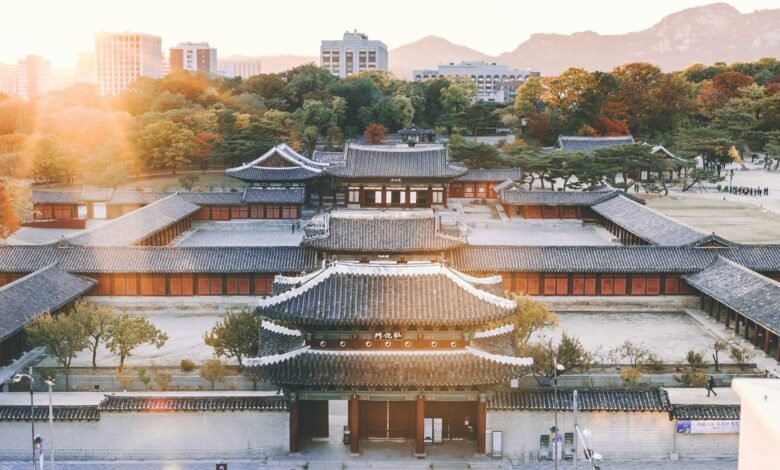Experience Korea’s Rich Architecture: Highlights from Tradition to Modernity

The architecture of Korea is a wonderful synthesis of modern invention, history, and culture. From the elegant skyscrapers and contemporary styles of modern Korea to the ancient palaces and temples exhibiting centuries of legacy, the architecture of Korea tells a distinctive narrative of its development. If you are going to Korea, seeing these architectural wonders ought to be top priority.
Staying in touch may be crucial for navigation, research, or ticket booking to certain famous places as you explore Korea. Using an eSIM is among the simplest methods to remain in touch. eSIM for Korea allows you to instantly access mobile data without having to go through SIM card swapping trouble. eSIM Korea allows you to obtain maps, tour guides, and critical updates while visiting both modern and historic sites all throughout Korea.
Let us investigate the rich architectural legacy and contemporary masterpieces defining the scene of Korea.
Traditional Korean Architecture
1. Gyeongbokgung Palace (Seoul)
Among the most recognizable sites in Korea is Gyeongbokgung Palace. Designed during the Joseon Dynasty in 1395, it was the principal royal residence and now a reminder of the rich past of the nation. With its enormous courtyards, graceful buildings with arching tiled roofs, and richly colored wooden beams painted on, this palace is a great illustration of traditional Korean architecture.
Design of the palace emphasizes harmony with surroundings. Carefully symmetrically arranged, the buildings are surrounded by lovely gardens and a mountain backdrop. With buildings meant to blend into their surroundings rather than stand out from one another, Gyeongbokgung’s architecture represents Korea’s great affinity to nature.
For guests, the palace offers a cultural encounter in addition to architectural magnificence. Explore the National Palace Museum, see the guard changing of the ritual, and gain further knowledge about royal history of Korea. Early in the day visits or advance ticket booking will help you avoid crowds.
See also: Journey to Wellness: Discovering Afkickkliniek Rehabilitation Centers in Durban, South Africa
2. Bukchon Hanok Village (Seoul)
Bukchon Hanok Village, a living museum of ancient Korean architecture, is tucked away in Seoul between Gyeongbokgung Palace and Changdeokgung Palace Hundreds of well-preserved hanok houses, with slanted tiled rooftops and timber frames, call the town home. These houses capture the way Koreans used natural materials like clay and wood to live in harmony with their surroundings.
With little lanes and quaint houses that have endured for decades, walking through Bukchon lets you glimpse the past. Built to fit Korea’s four seasons, the hanok homes include unique features meant to keep them cool in summer and warm in winter. Bukchon is still a residential area even although it is now a well-liked tourist site; so, visitors are advised to treat the local people respectfully. With historic homes and breathtaking views of the city.
A trip to Bukchon lets you really engage with Korea’s past. On foot, this is a fantastic place to explore with many of picture chances along the route.
3. Bulguksa Temple (Gyeongju)
One of the most respected Buddhist monuments in Korea and a UNESCO World Heritage Site, Bulguksa Temple is situated in Gyeongju The construction of the temple provides evidence of the splendor of the Silla Dynasty, which governed Korea from 57 BC to 935 AD. Bulguksa is well-known for its magnificent stone pagodas, complex carvings, and thoughtful architectural layout meant to evoke peace.
With its symmetrical arrangement signifying harmony and balance, the temple is meant to mirror Buddhist ideas. The temple’s beauty resides in its tranquil environment as much as in its construction. Nestled with verdant forests and mountain vistas, Bulguksa provides guests with an opportunity to commune with the natural world while valuing the site’s spiritual relevance.
Spend time touring the temple grounds and its several halls, which feature exquisite Buddhist sculptures and artwork. See the adjacent Seokguram Grotto, which features a magnificent Buddha figure cut into the rock.
Transition to Modern Architecture
1. Changdeokgung Palace and the Secret Garden (Seoul)
Another amazing location in Seoul, Changdeokgung Palace masterfully blends environment with traditional architecture. Designed for the royal family’s personal use, this Joseon Dynasty construction is renowned for its magnificent garden, sometimes known as the Secret Garden (Huwon). Unlike the more formal architecture of Gyeongbokgung, Changdeokgung was built to harmonize with the surrounding terrain by means of building arrangement.
Changdeokgung’s design follows feng shui’s ideas, in which every structure and road is positioned deliberately to promote balance and good fortune. With its pavilions, paths, and ponds, The Secret Garden is the ideal illustration of how classic Korean architecture and landscape may coexist.
With its verdant grounds and peaceful surroundings, Changdeokgung offers a more subdued experience than Gyeongbokgung. Examining the history and beauty of the palace allows one to unwind and ponder.
2. National Museum of Modern and Contemporary Art (Seoul)
Korea’s architecture changed throughout the course of its history. One excellent illustration of how Seoul adopted modern design while respecting its architectural legacy is the National Museum of Modern and Contemporary Art (MMCA). Nestled in the middle of the city, the museum’s simple architecture stands out against the elaborately traditional buildings around.
The wide areas, big glass windows, and simple lines of the building mirror contemporary Korean architecture. Inside, guests may see a broad spectrum of modern art including multimedia works, paintings, and sculptures. Showcasing a mix of history and modernism in its building and displays, the museum represents Korea’s increasing impact in the art and design sphere.
MMCA is absolutely must-see for guests drawn in by modern architecture and art. The structure itself is a work of art; its displays provide a window into Korea’s contemporary cultural scene.
Modern Architectural Marvels
1. Dongdaemun Design Plaza (Seoul)
Designed by noted architect Zaha Hadid, Dongdaemun Design Plaza (DDP) is among Seoul’s most futuristic constructions. The plaza has a flowing, undulating form that resembles another planet. Its natural, flowing lines give it movement and help to set it apart from the more conventional buildings around the city.
Hosting events like fashion shows, design and creative hub DDP hosts cultural activities. Its creative design has come to represent Korea’s forward-looking approach toward architecture and technology. The plaza is a busy place for residents as well as visitors since it features stores, cafes, and a museum.
One excellent approach to see Korea’s innovative architectural and energetic design scene is by visiting DDP. The structure itself is a work of art, and its inside areas are equally remarkable than its outside ones.
2. Lotte World Tower (Seoul)
Rising to 555 meters, the Lotte World Tower is fifth tallest in the world and the highest structure in Korea. Its elegant, tapering form reflects Korea’s contemporary skyline and fast urban growth. Offering offices, luxury homes, a hotel, and a shopping mall, the tower serves as a center for business and recreation.
With sophisticated technologies applied to guarantee its stability and safety, the Lotte World Tower is an engineering wonder. With an eye toward sustainability and efficiency, its contemporary design represents Korea’s global economic might. An elevator will let guests to the observation deck, which provides amazing views of Seoul and the surrounds.
Anyone fascinated with modern architecture and breathtaking city views ought to visit the Lotte World Tower.
3. The National Library of Korea (Seoul)
One outstanding illustration of how contemporary architecture could interact with its surrounds is the National Library of Korea. The sleek, understated architecture of the building combines open areas, big glass windows, and a straightforward but arresting front. Visitors can not only admire Korea’s enormous library of books and materials but also value the building’s design.
Surrounded by lovely gardens and walkways, the library is in a quiet area. While appreciating the modern architecture that distinguishes the library, this is a perfect place to unwind and enjoy the calm environment.
Final Thought
From its rich traditional buildings to the audacious, futuristic styles defining Korea today, the architectural scene of the nation presents a remarkable trip through time. Every architectural site—from the Dongdaemun Design Plaza’s contemporary forms to the calm grounds of Bulguksa Temple to your meandering through the royal palaces of Seoul—tells a tale about Korea’s rich history, culture, and development.
From modern skyscrapers to historic palaces, Korea’s architecture is the ideal mix of the old and the contemporary. Spend some time visiting these architectural masterpieces to see personally how wonderfully linked Korea’s past and future are. Using current technologies to plan your trip will only improve the experience and enable you to discover the finest that Korea has to offer.



